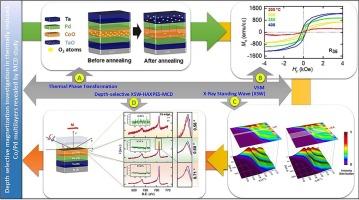MCD研究表明热还原Co/Pd多层膜的深度选择性磁化
IF 6.9
2区 材料科学
Q2 CHEMISTRY, PHYSICAL
引用次数: 0
摘要
研究重点是通过系统的热退火工艺将含钴多层材料还原为金属钴(Co),以及随后结构和磁性能的变化。还原后的结构显示出明显的电子密度变化,证实了氧化钴的还原。在还原过程后,观察到体系的总磁矩显著增加,表明磁性能有了质的改善。还原后的Co层在平面方向上表现出磁性取向的对称性,表明外加磁场作用下的磁响应不受方位角的影响。此外,钴层的深度分辨分析显示,钴的本体和界面区域之间的磁性能有明显的差异,揭示了与深度相关的磁性剖面的微妙外观。研究结果表明,界面工程不仅是控制多层结构磁功能的有力工具,而且丰富了对界面和表面微观现象的科学理解。这项研究证明,通过结构调谐可以实现磁性能的理想改善,为未来的自旋电子应用铺平了道路。本文章由计算机程序翻译,如有差异,请以英文原文为准。

Depth selective magnetization investigation in thermally reduced Co/Pd multilayers revealed by MCD study
The investigation focuses on the reduction of cobalt oxide-containing multilayers to metallic cobalt (Co) through a systematic thermal annealing process and the subsequent changes in the structural and magnetic properties. The reduced structures show a significant change in the electron density profile, confirming the reduction of cobalt oxide. After the reduction process, a significant increase in the overall magnetic moment of the system is observed, indicating a qualitative improvement in the magnetic properties. The reduced Co layer shows symmetry of magnetic orientation in the planar direction, indicating that the magnetic response under the application of an external magnetic field is unaffected by azimuthal angle. Moreover, the depth-resolved analysis of the Co layer revealed that there is a clear difference in the magnetic properties between the bulk and interface region of cobalt, revealing the subtle appearance of a depth-dependent magnetic profile. The presented findings illustrate that interface engineering is not only a powerful tool for controlling the magnetic functionality of multilayer structures but also enriches scientific understanding of the microscopic phenomena occurring at interfaces and surfaces. This study proves that desirable improvements in magnetic properties can be achieved by structural tuning, paving the way for future spintronic applications.
求助全文
通过发布文献求助,成功后即可免费获取论文全文。
去求助
来源期刊

Applied Surface Science
工程技术-材料科学:膜
CiteScore
12.50
自引率
7.50%
发文量
3393
审稿时长
67 days
期刊介绍:
Applied Surface Science covers topics contributing to a better understanding of surfaces, interfaces, nanostructures and their applications. The journal is concerned with scientific research on the atomic and molecular level of material properties determined with specific surface analytical techniques and/or computational methods, as well as the processing of such structures.
 求助内容:
求助内容: 应助结果提醒方式:
应助结果提醒方式:


